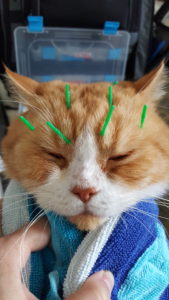TCVM Intro
Traditional Chinese Veterinary Medicine Introduction (TCVM)
The Five Branches of Traditional Chinese Medicine
“You just said 5, but elsewhere on this website, it says 4,” says an astute reader.
“Yes, there are 4 branches of Traditional Chinese Veterinary Medicine (for critters) and 5 branches of Traditional Chinese Medicine (for people,)” says Doc Truli.
- Food therapy
- Herbal Therapy
- Acupuncture
- Tui na medical massage
- Qi-gong practice
Food Therapy
Chinese Medical practitioners have known for 2,000 years that certain foods have specific effects on the body. If you think about it, every living thing has an intelligence – an organizing principle – that directs it to grow and reproduce and thrive in order to survive. Our pets have that intelligence, too. Eating optimal foods brings out the best in our health. For example, if we feel cold, we eat warming comfort foods, like oatmeal or chicken soup. If we are hot, we drink iced tea or eat watermelon to cool off. If we feel weak, we may eat Beef to strengthen ourselves. Or we may feel lethargic and “heavy” and eat simple, organic meals with lots of fresh vegetables to feel “cleaner,” and “clearer.” With Traditional Chinese Veterinary Medicine, the guesswork is gone and we select specific foods and meal preparations that will give us the desired effect in the body. Food
therapy makes up the majority of medical traditional medical practice in China today.
Herbal Therapy
We know certain herbs have specific medical effects. Aspirin came from Willow bark. Many, many medicines are extracted and refined from herbal sources. When the herbs are combined in a remedy, we should know if they cancel each other out, if they interact with each other to lessen the good effects, if they help each other and have a synergistic, greater positive effect than each herb individually. In the United States, there is no requirement for an herbal company to test and prove what the final mix of herbal remedies dies all together. You do not know if the remedies actually cancel each other
out! Or worse!
Chinese medicine has found thousands of combinations of herbs with specific synergistic effects. The formulas are designed to minimize or eliminate side-effects and maximize therapeutic (good) effects. Some of these formulas are over 2000 years old and new ones are being designed today! You may have heard that there are dangerous Chinese herbs. There are. Only a handful. A trained, experienced herbalist like Dr Truli will know to absolutely avoid those herbs. You may have also heard of adulterated, cheat, or contaminated products from China. Dr Truli only orders from Jing Tang Herbal in Reddick Florida and run by her teacher, Dr Xie (pronounced “shay.”) The herbs are all triple tested for identity, strength, purity and contamination-free. Additionally, each batch is sampled and the samples are available for testing 10 years after the mix!
Herbal medicine makes up more than half of the medical treatment plan.
Acupuncture
Acupuncture is the flashy, fun part of Traditional Chinese Medicine. This is the part that feels like you are “doing something.” It is wonderful to see your dog walk for the first time in a week just minutes after an acupuncture treatment. Or see a hopeless case of paralysis cure. Or see a pet with a fatal kidney failure diagnosis stop vomiting, gain weight, and feel happy 2+ years after the Specialists had to give up on him.
“Acupuncture can give us quick results, pain relief, return to function,” says Dr Truli. “Acupuncture can synergize with food therapy, tui na, and herbal therapy to speed healing, minimizing discomfort and over-all cost.”
Topographic acupuncture is a minimal needle, distal point, ultra-rapidly acting and highly efficacious system of Channel-diagnosed acupuncture. This acupuncture technique may use 1 to 3 needles to treat the whole body.
Acupuncture makes up less than 20% of traditional medical practice in China.
Tui-na Medical Massage
This is pronounced “twee-nah.” It is also called an-mo or even tui-na an mo depending which part of China you are visiting.
“This medical massage takes our knowledge of the acupuncture channels and the subtle relationships between the functions in the body and, using our hands and our good intention, we aid healing, pain relief, and normal function to return to the body,” says Dr Truli. “You can learn specific simple techniques do help your pet in between vet visits.”
Tui-na is truly amazing and you can see your cat or dog or guinea pig or horse or…get a dreamy look on their face, relax, sleep, yawn, or stretch and you know they have let go of tensions and pain that were inhibiting healing.
Qi-Gong
This is pronounced “chee gung.” This is the practice of mindful movements in order to balance and support transformation and flow of energy in the body. Simply put, it is movement for health. Practices such as Tai-chi and Qi-gong fall into this category. Obviously, we cannot convince out cats and dogs to practice standing like a tree or moving like fire. This 5th branch of Chinese Medicine is thought to not be applicable to our pets.
“I like to think of play as Qi-gong for our pets,” says Dr Truli.
To learn more about TCVM, please visit the Chi Institute online.
Dr. Sandra Truli Springer, VMD, CVA, CVFT, CVTP, CVCH, CTCVMP
“Truli holistic veterinary services” | Care provided in your home!
Greater Tampa Bay, Florida, USA
Call toll-free 1 (877) DR TRULI | (877) 378-785







